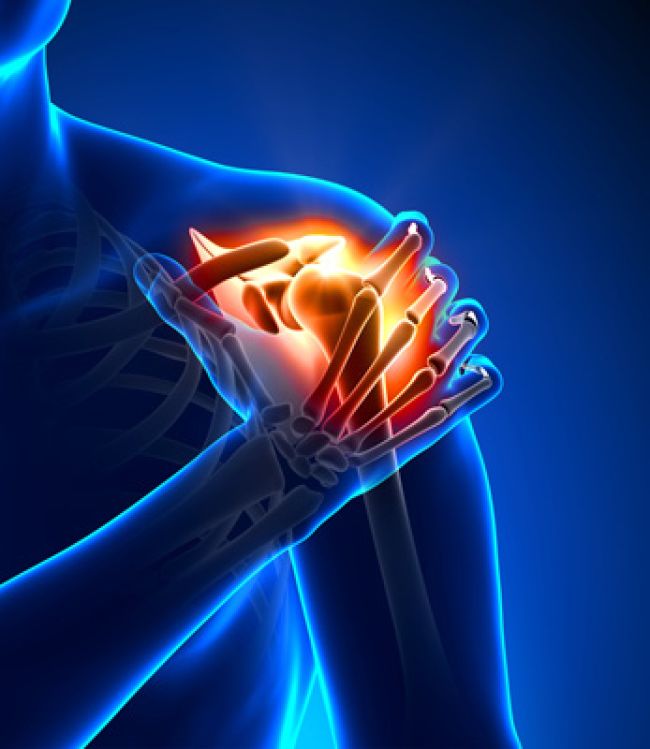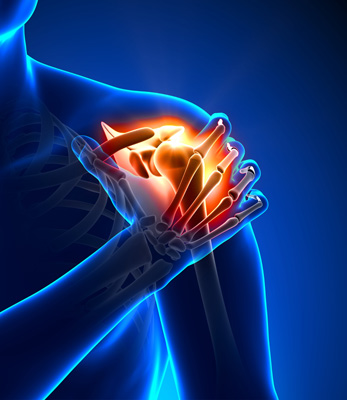
The Causes and Prevention of Shoulder Injuries in the Electric Distribution Field

It’s 3 a.m. Once again the dull ache stirs you from sleep. The first time was at midnight. Now the ache in your shoulder is telling you it’s time to roll onto your other side. Hopefully this will be the last time this happens tonight.
For far too many lineworkers, this has become a nightly ritual. In 2004, Business Health Resources conducted a symptom survey of 224 overhead electric employees who worked for one public utility, and it revealed that 56 percent of them experienced shoulder pain a couple times a week or more often. Many experienced shoulder pain on a daily basis. Because shoulder problems are so common, most lineworkers have come to believe they are just part of the job. Are they really, or can they be prevented?
Shoulder conditions can occur as a result of acute trauma injuries like falls or car accidents, or they can occur from cumulative trauma, which is the slow wear and tear that takes place over time, usually due to performing repetitive and physically demanding tasks using stressful working postures. The problem with cumulative trauma is that as the damage accumulates, you always feel pretty good – right up to the moment you are in pain. It’s a sneaky problem.
To understand what leads to cumulative trauma, we first need to cover some basic anatomy of the shoulder joint. It is a loose ball-and-socket joint, making it highly mobile so we can put our hands wherever they are needed. The price we pay for all of this mobility, however, is a loss of structural stability.
If you place your fingers on top of your shoulder, the bony little lump you feel is the acromioclavicular – or AC – joint, which is the joint between the collarbone and your shoulder blade. It is the only bone-to-bone connection between your arm and the rest of your body. The AC joint is about the size of the joint at the base of your thumb, and yet it has to safely transmit all of the stresses from your arms to the rest of your body. This design makes the shoulder far more susceptible to wear-and-tear injuries, especially when it is subjected to abnormal stresses, like those that come from performing line work using stressful techniques.
It is also important to understand that when you work with your arm, the rotator cuff tendon glides in the space between the top of the arm bone and the roof of the shoulder. The tendon provides a lot of stability for the shoulder joint. A fluid-filled sac – the bursa – also sits in this space and acts as both a cushion and a frictionless surface to minimize wear and tear on the tendon as it moves in this space.
Now that we’ve addressed the anatomy of the shoulder, let’s look at some common types of shoulder issues and injuries that commonly afflict lineworkers.
Shoulder Muscle Soreness and Pain
Most cumulative shoulder trauma begins with muscle soreness and pain. Anyone knowledgeable about exercise understands that when you perform physical labor or exercise, you microscopically tear muscle tissue. As the muscle tissue repairs itself over the following several days, it over-repairs the damage and makes each muscle fiber stronger and healthier than it was before the exercise occurred. When you perform repetitive physical work using stressful techniques, you can overwork the muscles you are using, tearing more tissue than you are capable of repairing. If you use stressful techniques every day, your muscles slowly start to become weak and painful as more damage accumulates. This is like overtraining in a gym. Overworked and damaged muscles go into spasm and can cause shoulder pain.
What makes a working technique more stressful? Distance, for one thing. If you have ever held an object that weighs 20 pounds at a full arm’s distance from your body, you know that you work a lot harder than if you had held that same weight up against your body. Habitually working with your arms farther away from your body than necessary can lead to fatigue of the shoulder muscles, muscle spasms and pain. Over the years this can cause other shoulder problems to develop.
Shoulder Impingement Syndrome
Shoulder impingement syndrome is a common problem that occurs when the tendon and bursa get compressed between the arm bone and the bony roof of the shoulder, typically when the arm is working above shoulder height. This compression primarily happens for three reasons.
First, when you contract your deltoid muscles to lift the arm, there is a tendency for the arm bone to get pulled upward within the joint. Normally, if the rotator cuff muscles are strong enough, they prevent this upward movement and compression by pulling down on the head of the arm bone known as the humerus. But if the rotator cuff muscles are weaker than they should be, the head of the arm bone will get pulled up within the joint and compress the tendon and bursa whenever work is performed with the arms overhead. Strong rotator cuff muscles are essential to prevent shoulder impingement syndrome.
Another common cause of impingement is working with the elbow at or above shoulder height and the palm of the hand either facing down or away from the body. These positions are referred to as “elbow high palm down” and “elbow high palm away.” When the arm is up and you rotate it so that your palm is facing down or away, a large lump of bone – known as the “greater tuberosity” – rotates directly into the joint space and compresses the tendon and bursa. When the arm is up but the palms face inward or up (“elbows high palm in” or “elbows high palm up”), this compression does not occur because the tuberosity is not in a position where it can compress the tendon.
The last common cause of shoulder impingement are bone spurs that develop as the AC joint becomes arthritic from years of working overhead with stressful postures. The bone spur points down onto the tendon and digs into it as the tendon moves back and forth.
All of the causes of shoulder impingement mentioned in this article can ultimately result in rotator cuff tendinitis, tendinosis, tendon tearing, bursitis, calcification of the bursa and degenerative arthritis of the shoulder.
Biceps Tendinitis, Tendinosis and Tenosynovitis
Biceps tendinitis, tendinosis and tenosynovitis can occur secondary to shoulder impingement or independent of it. The tendon of the long head of the biceps is unique in that it passes within the ball-and-socket joint of the shoulder. Chronic inflammation of the shoulder joint will slowly damage this tendon via inflammatory enzymes. Pulling and rotating the arm in an overhead position can also slowly stress and damage the tendon. Obviously, anything else that creates additional shoulder stress – like pushing and pulling wrenches, or pumping come-alongs with the arms farther from your body than they have to be – contributes to this condition as well.
Degenerative Arthritis
Degenerative arthritis is nothing more than wear and tear of a joint. Working in more stressful ways will eventually lead to arthritic changes of the AC joint. Old injuries that have not completely repaired themselves and leave the joint loose and unstable can lead to impingement and degenerative arthritis as the stress slowly wears down and tears the joint. Previous shoulder separations are probably one of the most common causes of this because these injuries rarely heal correctly.
Reducing Risk of Injury
So, what can lineworkers do to decrease or eliminate risk of shoulder injury and damage?
First, keep your rotator cuff muscles strong and healthy through regular exercise and daily stretching; this will minimize shoulder impingement.
Second, use less stressful working techniques. Keep your elbows lower and closer to your body whenever you can do so without violating safe approach distances. When possible and safe, elbows should also be kept low and close as you hold hot sticks, push and pull wrenches, manually dig and tamp pole holes, lift tools and equipment, pump come-alongs, and use choppers and crimpers. Note that using powered choppers and crimpers can save your shoulders some stress.
Other working techniques that reduce shoulder stress include raising your bucket a little higher, stepping up on the next rung of the ladder you are using and taking one more step up on a pole if it is safe to do so, and if doing so will bring your elbows lower or closer to your body.
Third, coach yourself so you can identify those times when you are working with your elbows at shoulder height or above with the palms facing down or away. Figure out ways to change your body’s position, the movements you are making, or the way you are holding a tool so that your elbows are lower or the palms face inward or up.
Too often we take our health for granted until it is in decline, and then we wish we could get it back. You will never be able to work from a perfect position all of the time, but 17 years of experience working with men and women in the electric distribution field has shown me that if you take the initiative, you will be surprised by how often you can find a less stressful way to work. And if you don’t do this for yourself, who will?
About the Author: Dr. Andrew Murro, DC, DABCO, was a practicing chiropractic orthopedist from 1984 to 1999. He is president of Business Health Resources LLC and founder of the Ergo-Power Injury Prevention Program. Since 1999 Murro has worked with electric, gas and water utilities, as well as companies in the manufacturing and service industries, to help them develop and implement sustainable soft tissue injury prevention strategies. He can be reached at amurro@ergo-power.com.

